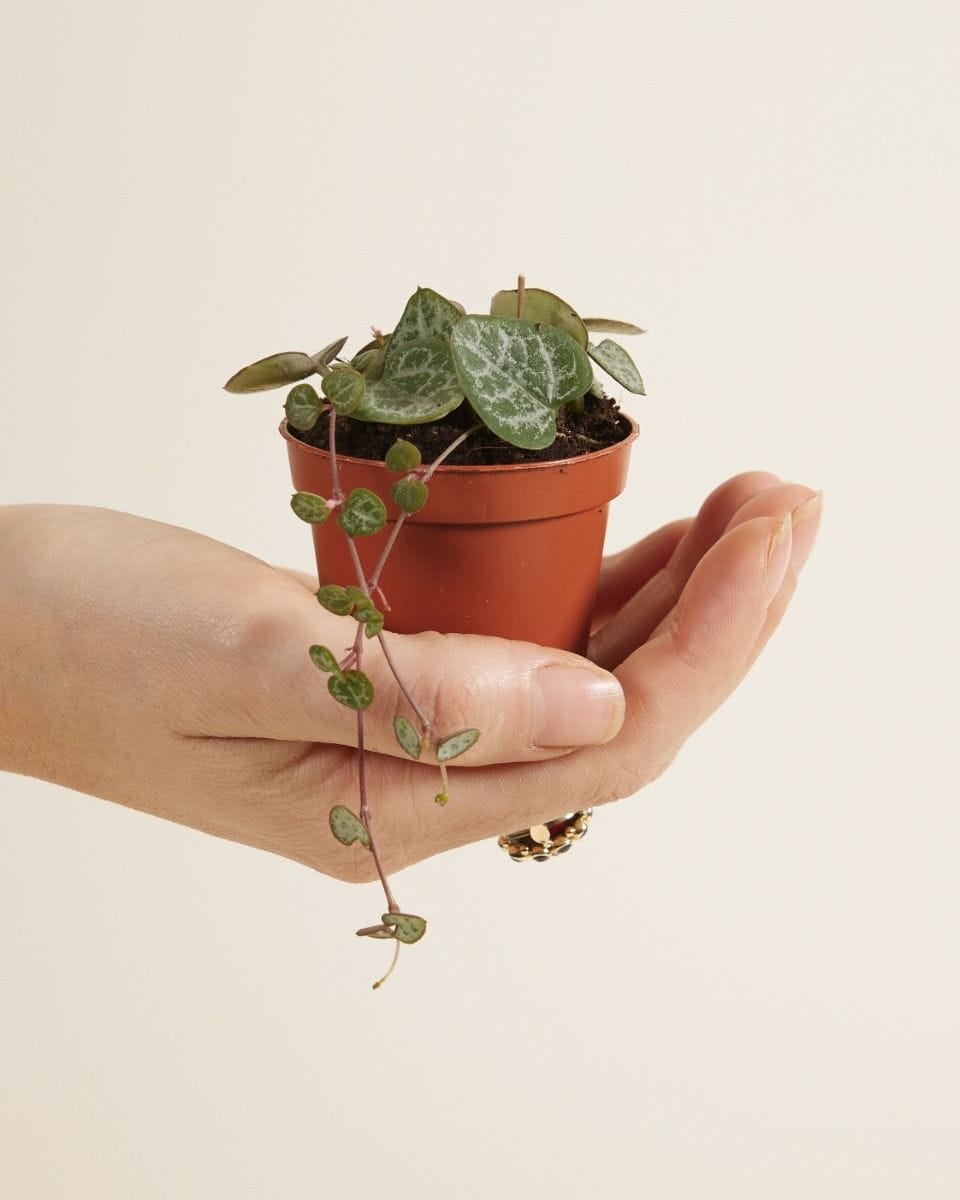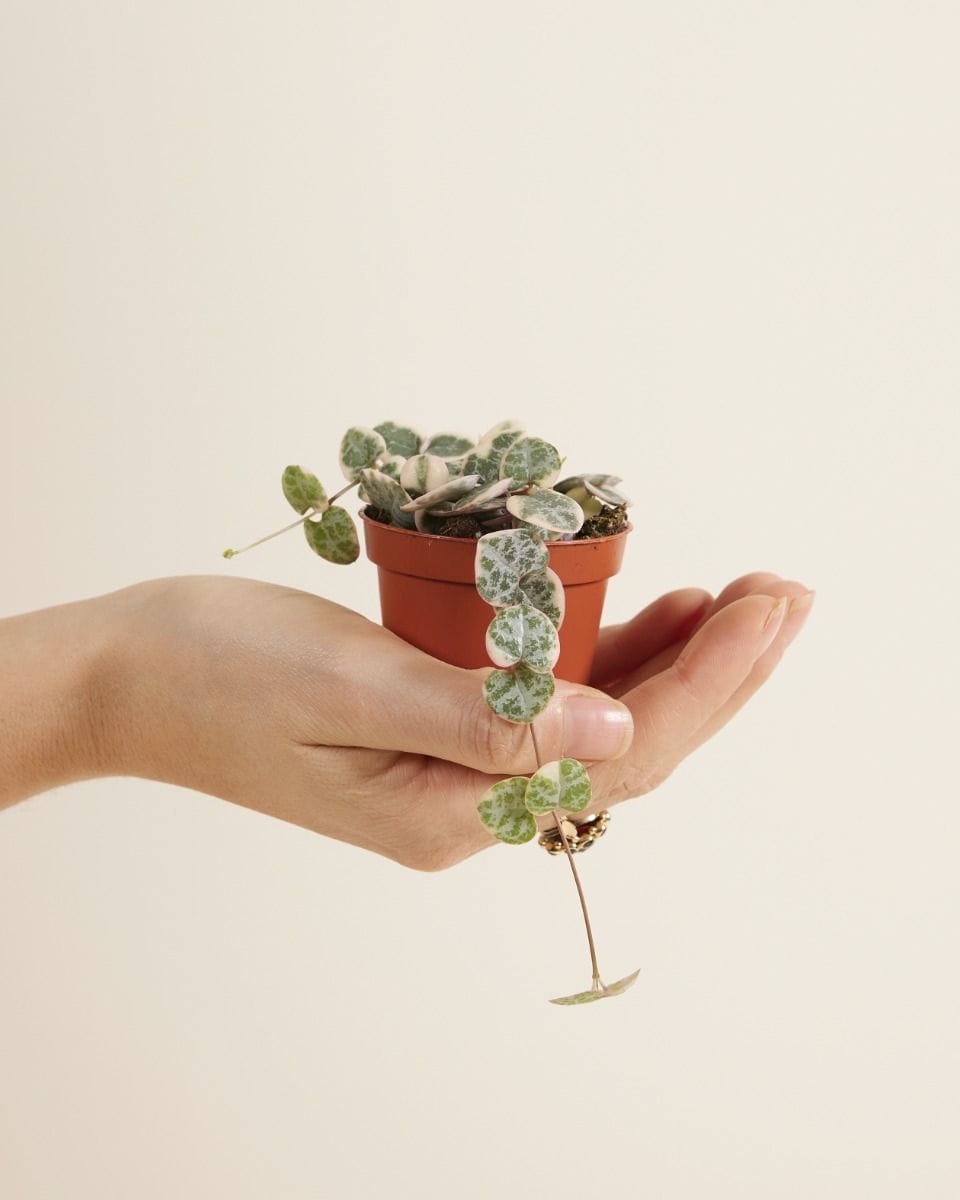In diesem Artikel
- 1 Ceropegia Pflege: Expertentipps für glückliche Pflanzen
- 1.1 Ceropegia Pflege: 10 Expertentipps für die erfolgreiche Haltung
- 1.2 Ceropegia Pflege
- 1.2.1 Licht & Standort
- 1.2.2 Gießen
- 1.2.3 Dünger
- 1.2.4 Temperatur & Luftfeuchtigkeit
- 1.2.5 Erde, Substrat & Umtopfen
- 1.3 Ceropegia Vermehren
- 1.4 Häufige Schädlinge und Krankheiten bei Ceropegia
- 1.5 Sind Ceropegia giftig?
- 1.6 Kauf deine neue Ceropegia online bei PLNTS.com
Ceropegia Pflege: Expertentipps für glückliche Pflanzen
Die zur Gattung Ceropegia gehörende Ceropegia ist eine vielfältige Gruppe von rankenden Pflanzen, die für ihre charakteristischen Blätter und ihre oft ungewöhnlichen Blüten bekannt sind. Diese Pflanzengattung ist Teil der Familie der Apocynaceae. Die Ceropegia ist in Afrika, Südasien und Australien heimisch. Es sind mindestens 420 Arten bekannt, und es werden regelmäßig neue Arten entdeckt und beschrieben. Bei den meisten Arten sind die Stängel kletternd oder hängend.

Ceropegia Pflege: 10 Expertentipps für die erfolgreiche Haltung
- Stelle deine Ceropegia an einen warmen, hellen Ort. Vermeide direktes Sonnenlicht, da es die Blätter verbrennen kann. Ein nach Norden oder Osten ausgerichtetes Fenster ist normalerweise ideal.
- Halte eine konstante Temperatur zwischen 15-27 °C aufrecht. Diese Pflanzen können etwas kühlere Temperaturen vertragen, sind aber frostempfindlich.
- Gieße sparsam, aber gründlich. Lass den obersten Zentimeter der Erde austrocknen, bevor du gießt. Eine Überwässerung kann zu Wurzelfäule führen, daher ist es besser, die Pflanzen nicht zu stark zu gießen.
- Verwende eine gut durchlässige, leichte Erdmischung. Eine Kakteen- oder Sukkulentenmischung ist geeignet. Achte darauf, dass der Topf Drainagelöcher hat, damit sich kein Wasser am Boden ansammelt.
- Topfe deine Ceropegia alle 2-3 Jahre um, oder wenn die Wurzeln den Topf ausfüllen. Wähle einen etwas größeren Topf und frische die Erde beim Umtopfen auf.
- Dünge deine Ceropegia während der Wachstumsperiode alle 4-6 Wochen mit einem ausgewogenen, wasserlöslichen Dünger. Vermeide eine Düngung während ihrer Ruhephase in den Wintermonaten.
- Ceropegias sind nicht besonders feuchtigkeitsempfindlich, aber sie freuen sich über ein wenig zusätzliche Feuchtigkeit. Du kannst die Pflanze gelegentlich besprühen oder eine Schale mit Wasser und Kieselsteinen in die Nähe der Pflanze stellen, um die Luftfeuchtigkeit zu erhöhen.
- Schneide deine Ceropegia nach Bedarf, um ihre Form zu erhalten und einen buschigeren Wuchs zu fördern. Schneide krumme oder beschädigte Stängel ab, um ein gesundes Wachstum zu fördern.
- Achte auf häufige Zimmerpflanzenschädlinge wie Blattläuse, Wollläuse und Spinnmilben. Wenn du einen Befall feststellst, behandle ihn umgehend mit insektizider Seife oder Neemöl.
- Ceropegia-Pflanzen lassen sich durch Stammstecklinge vermehren. Nimm einen Steckling mit mindestens einem Knoten und lass ihn ein oder zwei Tage lang kallusieren, bevor du ihn in eine gut durchlässige Substratmischung pflanzt. Halte den Steckling leicht feucht, bis er Wurzeln geschlagen hat.
Ceropegia Pflege
Licht & Standort
Ceropegias gedeihen in hellem, indirektem Sonnenlicht. Stelle sie in der Nähe eines nach Norden oder Osten ausgerichteten Fensters auf, wo sie den ganzen Tag über viel indirektes Sonnenlicht abbekommen. Direkte Sonneneinstrahlung, vor allem in der heißen Nachmittagssonne, kann die Blätter verbrennen, daher solltest du bei Fenstern, die nach Süden oder Westen ausgerichtet sind, vorsichtig sein.
Experten-Tipp! Die hängenden Ranken von Ceropegia eignen sich hervorragend für Blumenampeln. Durch die Aufhängung der Pflanze können die Ranken anmutig herabhängen und erhalten gleichmäßig Licht.
Gießen
Der String of Hearts ist eine Sukkulentenähnliche Pflanze, die zwischen den Wassergaben Trockenperioden bevorzugt. Wenn die Erde im Topf zu 2/3 trocken ist, ist die Pflanze reif für einen Schluck Wasser. In den Wintermonaten ist es am besten, die Erde vollständig austrocknen zu lassen. Diese Pflanzen gehen in eine Ruhephase, auch im Haus. Sie sind empfindlich gegen Wurzelfäule und Überwässerung, daher sollte man im Zweifelsfall lieber einmal weniger gießen.
Experten-Tipp! Vermeide es, sehr kaltes oder heißes Wasser direkt aus dem Wasserhahn zu verwenden. Lass das Wasser vor dem Gießen auf Zimmertemperatur kommen, um die Wurzeln der Pflanze nicht zu schocken.
Dünger
Ceropegien haben normalerweise im Frühjahr und Sommer eine aktive Wachstumsphase. Dünge deine Pflanzen in dieser Zeit am besten mit einem organischen Pflanzendünger wie unserem PLNTSdünger. Dünge deine Ceropegia während der Wachstumsperiode alle 4-6 Wochen.
Denk daran, dass Ceropegia-Pflanzen keine Starkzehrer sind, und dass es wichtig ist, nicht zu viel zu düngen.
Temperatur & Luftfeuchtigkeit
Die Aufrechterhaltung der richtigen Temperatur und Luftfeuchtigkeit ist für die Gesundheit und das Wohlbefinden deiner Ceropegia von entscheidender Bedeutung. Sie gedeihen in einem konstanten Temperaturbereich von 15-27 °C. Sie können auch etwas kühlere Temperaturen vertragen, sind aber empfindlich gegenüber Frost. Achte auch auf Zugluft, Klimaanlagen, Heizkörper und Heizungen, da Temperaturschwankungen die Pflanze belasten können.
Ceropegia-Pflanzen sind relativ anpassungsfähig an die Luftfeuchtigkeit in Innenräumen und benötigen keine hohe Luftfeuchtigkeit. Allerdings freuen sie sich über ein wenig zusätzliche Feuchtigkeit. In den meisten Wohnungen sollte die natürliche Luftfeuchtigkeit ausreichen.

Erde, Substrat & Umtopfen
Ceropegia-Pflanzen sind technisch gesehen keine Sukkulenten, aber man sollte sie als solche betrachten. Vor allem, was die Art der Erde betrifft. Die Drainage des Bodens ist für diese Pflanze entscheidend. Verwende eine Sukkulenten-/Kakteenmischung oder mische normale Blumenerde mit Perlite und Kokosfasern in einem Topf mit Drainagelöchern. Damit soll verhindert werden, dass sich um die Wurzeln herum Wasser ansammelt, was zu Wurzelfäule führen kann.
Was das Umtopfen anbelangt, so solltest du deine Ceropega umtopfen, wenn die Wurzeln den ganzen Topf ausfüllen oder wenn du feststellst, dass die Pflanze aus ihrem derzeitigen Topf herauswächst. Der beste Zeitpunkt für das Umtopfen ist in der Regel im Frühjahr, wenn die Pflanze aktiv wächst.
Ceropegia Vermehren
Die gebräuchlichste und erfolgreichste Methode sind Stammstecklinge, bei der gesunde Stämme mit Knoten vorsichtig in gut durchlässige Erde gepflanzt werden und ein feuchtes Milieu erhalten. Mit ein wenig Pflege und Geduld werden diese Stecklinge Wurzeln bilden und schließlich zu ausgewachsenen Zimmerpflanzen heranwachsen. Befolge die folgenden einfachen Schritte, um Stammstecklinge zu entnehmen:
- Nimm eine saubere, scharfe Schere oder ein Messer und schneide einen oder mehrere etwa 3-6 Zentimeter lange Stecklinge ab. Jeder Steckling sollte mindestens einen Knoten aufweisen, d. h. eine kleine Beule am Stamm, an der Blätter und Wurzeln wachsen.
- Stecke das abgeschnittene Ende jedes Stecklings in einen Topf, der mit einer gut durchlässigen Substratmischung gefüllt ist. Vergrabe den Steckling etwa 1-2 Zentimeter tief und achte darauf, dass der Knoten bedeckt ist. Wenn du mehrere Stecklinge vermehrst, solltest du diese voneinander trennen.
- Bedecke die Töpfe mit durchsichtigen Plastikbeuteln oder Plastikfolie, um ein feuchtes Milieu zu schaffen. Befestige die Beutel oder die Folie mit Gummibändern oder Kabelbindern um den/die Topf/Töpfe, wobei du um die Stecklinge herum etwas Platz für die Luftzirkulation lässt. Stelle die Töpfe in helles, indirektes Licht.
Experten-Tipp! Ceropegia-Zimmerpflanzen können auch (halb)hydroponisch kultiviert werden, was eine alternative Methode zur Kultivierung dieser einzigartigen Pflanzen darstellt.

Häufige Schädlinge und Krankheiten bei Ceropegia
Ceropegia-Zimmerpflanzen sind in der Regel widerstandsfähig, können aber von einigen häufigen Schädlingen und Krankheiten befallen werden. Wollläuse, Blattläuse und Spinnmilben gehören zu den häufigsten Schädlingen, die Ceropegia-Pflanzen befallen können. Diese Schädlinge können mit insektizider Seife oder Neemöl behandelt werden, und eine gute Pflanzenhygiene kann helfen, einen Befall zu verhindern.
Ausführlichere Informationen zur Erkennung, Behandlung und Vorbeugung von Schädlingen und Krankheiten bei Ceropegia-Zimmerpflanzen findest du auf unserer PLNTSdoctor-Seite.
Sind Ceropegia giftig?
Die Toxizität von Ceropegia-Pflanzen wird im Allgemeinen als gering eingestuft, und sie sind in der Regel nicht als hochgiftig für Haustiere oder Kinder bekannt. Sie können diese Pflanzen durchaus in einem Raum aufstellen, in dem Kinder und/oder Haustiere spielen, aber wir raten dir, sie immer im Auge zu behalten!
Kauf deine neue Ceropegia online bei PLNTS.com
Möchtest du deine Sammlung um eine charmante Ceropegia-Zimmerpflanze erweitern? Entscheide dich für die bezaubernde Ceropegia Woodii, besser bekannt als String of Hearts. Diese Hängepflanze ist die perfekte Ergänzung für deinen Zimmerdschungel! Ceropegia online kaufen bei PLNTS.com

